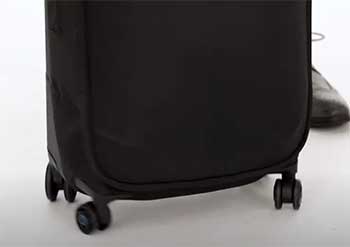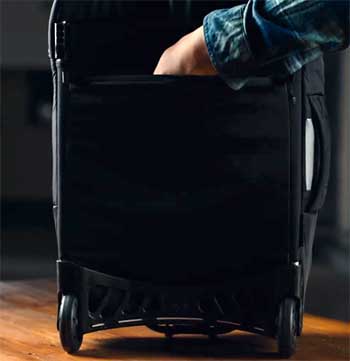In a world that’s always on the move, a trusty carry-on is your ticket to effortless travel. But the perennial question remains: which is better, a spinner or a 2-wheel carry-on?
This debate has seen many a traveler swap stories at airport lounges, leading to no definite answer. Today, we are putting this topic under the lens to provide you with a comprehensive comparison of these travel essentials.
A Brief Comparison Table
| Criteria | Spinner Carry-On | 2-Wheel Carry-On |
| Wheel Structure and Durability | Four externally mounted wheels, prone to damage | Two internally recessed wheels, more durable |
| Maneuverability | Excellent, can move in any direction | Good, moves forward and backward |
| Weight Distribution and Handling | Balanced, less physical effort required | Weight on arm/shoulder, more physical effort |
| Space Consumption | Consumes more space due to external wheels | More compact due to recessed wheels |
| Noise and Vibration | Less noise and vibration on smooth surfaces | May be noisier and vibrate more |
Also Read: Differences Between MVST TREK And SPACE Carry-On Suitcases.
A Spin on the Spinner
Also known as the 4-wheel carry-on, the spinner has a sleek 360-degree movement capability that gives it a certain level of charm. It’s the modern show-off among luggage styles and for some good reasons.
Pros of Spinner Carry-On

- Easy Maneuverability
The spinner’s defining feature is its ability to glide in any direction.
Whether it’s a crowded airport terminal or a cramped airplane aisle, its wheels can turn on a dime.
This makes it a breeze to navigate through tight spaces, reducing strain on your arms and shoulders.
- Balanced Weight Distribution
A key advantage of the spinner is that it carries its weight more evenly.
The four wheels allow the bag to stand upright without any support, and it effortlessly rolls alongside you with a gentle push, making it perfect for lengthy transit times.
- Versatility in Motion
The spinner wheels also let you move the luggage in various ways. You can pull it behind, push it in front, or slide it alongside you. This adaptability can be handy when navigating different terrains or spaces.
Cons of Spinner Carry-On
- Wheel Durability
Spinners often come with wheels that are attached externally, making them vulnerable to damage. They don’t fare well on rough surfaces and are prone to breakage, which can be a significant setback when traveling.
- Space Consumptions
The 360-degree spinning wheels protrude from the case, taking up extra space. This can be a disadvantage when dealing with strict carry-on dimensions at certain airlines.
Also Read: Differences Between Open Story And Away Luggage.
The 2-Wheel Classic
The 2-wheel carry-on is the traditional favorite, known for its durability and functionality. This ‘pull-behind’ case has its fans who swear by its simple and effective design.
Pros of 2-Wheel Carry-On

- Robustness and Durability
The wheels on 2-wheel carry-ons are partially recessed into the case, offering better protection.
This design tends to be more durable, especially on uneven or harsh terrains, making it the go-to choice for adventure travelers or frequent flyers.
- Space-Saving
The design of the 2-wheel carry-on is more compact as the wheels don’t add to its dimensions.
This means it’s easier to fit into overhead bins or under the seat in front of you.
Cons of 2-Wheel Carry-On
- Physical Strain
Unlike the spinner, the 2-wheel carry-on requires more physical effort as you have to tilt and pull it. This can be a hassle, especially if you’re on the move for an extended period.
- Limited Mobility
The 2-wheel carry-on can only move forwards or backwards, which means navigating tight spaces can be more challenging.
Key Differences Between Spinner and 2-Wheel Carry-On
The quintessential debate between the spinner and 2-wheel carry-on is not just about the number of wheels. It dives deeper into their structural design, functionality, and usability. Here are the key differences between the two.
- Wheel Structure and Durability
The most apparent difference between the spinner and 2-wheel carry-on is the wheel structure. Spinner luggage has four wheels that can turn 360 degrees, providing multi-directional movement.
On the other hand, the 2-wheel carry-on has two wheels, offering a linear movement.
The difference in wheel structure brings about the aspect of durability. Spinner wheels are often externally mounted and hence, more prone to damage, especially in rough terrains or during mishandling. This can be a serious concern when traveling.
Conversely, the 2-wheel carry-on’s wheels are partially recessed into the bag, offering better protection and more durability. If you’re a frequent traveler or prefer off-beat paths, this could be a deciding factor.
- Maneuverability
In terms of maneuverability, spinner luggage wins hands down. The 360-degree rotating wheels offer a seamless glide in any direction.
You can push it, pull it, or slide it alongside you, offering effortless navigation through tight spaces, like crowded airports or narrow airplane aisles.
The 2-wheel carry-on, however, has a unidirectional movement – forward or backward. This might make it slightly more challenging to navigate through tight spaces.
- Weight Distribution and Handling
Weight distribution is another key differentiator. The spinner carry-on stands upright and offers balanced weight distribution across its four wheels.
You just need to gently push the luggage, and it rolls along, making it ideal for long transit times or for those with physical limitations.
The 2-wheel carry-on requires you to tilt and pull, putting the weight on your arm or shoulder. This might cause strain if you’re traveling for an extended period.
- Space Consumption
While not immediately obvious, space consumption is an important aspect. Spinner wheels, due to their external mounting and 360-degree rotation, take up additional space. This might lead to issues with airlines with stringent carry-on size requirements.
The 2-wheel carry-on, with its recessed wheels, tends to be more compact, fitting into overhead bins or under the seat more easily.
- Noise and Vibration
Spinner carry-ons, with their four wheels, usually produce less noise and vibration while moving across smooth surfaces. On the flip side, 2-wheel carry-ons, due to their design and larger wheels, might be a bit noisier and produce more vibration.
Also Read: Differences Between 4 Wheel And 8 Wheel Spinner Luggage.
Frequently Asked Questions (FAQ)
Whether spinner wheels are better largely depends on the type of traveler you are. If you prefer easy maneuverability, enjoy long transits, and mostly move through smooth surfaces, then a spinner could be your best bet.
Double wheels on luggage can provide more stability and smoother handling. However, they also take up more space and may be more prone to breakage due to more moving parts.
The main disadvantages of spinner luggage are their external wheels that are prone to damage and the extra space they take up due to their 360-degree spinning design.
Spinner luggage is popular for its seamless maneuverability, balanced weight distribution, and versatile movement options. These features make them a preferred choice, especially for those navigating busy airports and smooth terrains.
Final Thoughts
In conclusion, both spinner and 2-wheel carry-ons have their unique advantages and drawbacks. It ultimately boils down to your travel needs, preferences, and the kind of journey you’re embarking on.
Understanding these key features will ensure you make a well-informed decision that enhances your travel experience.

